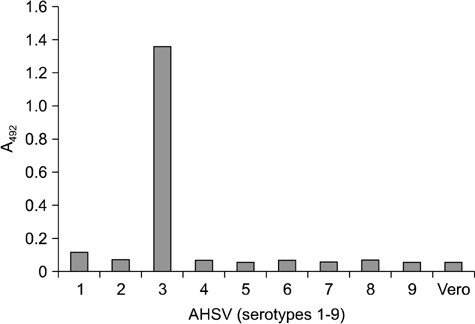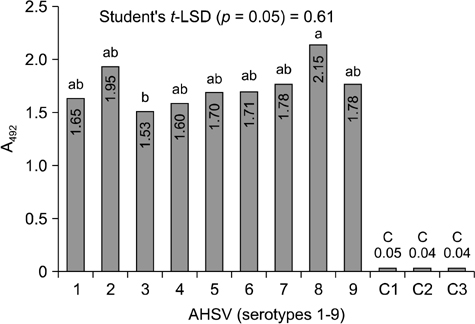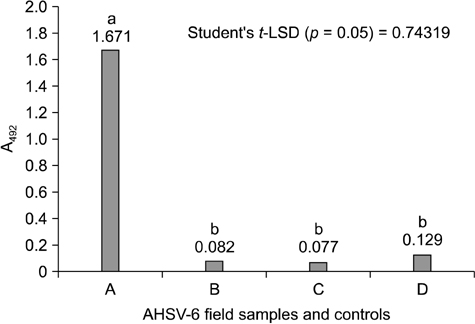J Vet Sci.
2013 Mar;14(1):95-98. 10.4142/jvs.2013.14.1.95.
Serotype- and serogroup-specific detection of African horsesickness virus using phage displayed chicken scFvs for indirect double antibody sandwich ELISAs
- Affiliations
-
- 1Immunology Division, Onderstepoort Veterinary Institute, Private Bag X05, Onderstepoort 0110, South Africa. vanwyngaardtw@arc.agric.za
- 2Deltamune, P. O. Box 14167, Lyttelton 0140, South Africa.
- KMID: 1482819
- DOI: http://doi.org/10.4142/jvs.2013.14.1.95
Abstract
- There is an ongoing need for standardized, easily renewable immunoreagents for detecting African horsesickness virus (AHSV). Two phage displayed single-chain variable fragment (scFv) antibodies, selected from a semi-synthetic chicken antibody library, were used to develop double antibody sandwich enzyme-linked immunosorbent assays (DAS-ELISAs) to detect AHSV. In the DAS-ELISAs, the scFv previously selected with directly immobilized AHSV-3 functioned as a serotype-specific reagent that recognized only AHSV-3. In contrast, the one selected with AHSV-8 captured by IgG against AHSV-3 recognized all nine AHSV serotypes but not the Bryanston strain of equine encephalosis virus. Serving as evidence for its serogroup-specificity. These two scFvs can help to rapidly confirm the presence of AHSV while additional serotype-specific scFvs may simplify AHSV serotyping.
Keyword
MeSH Terms
-
African horse sickness virus/*isolation & purification
Animals
Antibodies, Immobilized
Antibodies, Viral/*immunology
Cercopithecus aethiops
Chickens
Enzyme-Linked Immunosorbent Assay/methods/*veterinary
Immunoglobulin G
*Peptide Library
Serologic Tests/methods/veterinary
Serotyping
Single-Chain Antibodies/*immunology
Vero Cells
Antibodies, Immobilized
Antibodies, Viral
Immunoglobulin G
Peptide Library
Single-Chain Antibodies
Figure
Reference
-
1. Bremer CW, du Plessis DH, van Dijk AA. Baculovirus expression of non-structural protein NS2 and core protein VP7 of African horsesickness virus serotype 3 and their use as antigens in an indirect ELISA. J Virol Methods. 1994. 48:245–256.
Article2. Calisher CH, Mertens PP. Taxonomy of African horse sickness viruses. Arch Virol Suppl. 1998. 14:3–11.
Article3. Chuma T, Le Blois H, Sánchez-Vizcaíno JM, Diaz-Laviada M, Roy P. Expression of the major core antigen VP7 of African horsesickness virus by a recombinant baculovirus and its use as a group-specific diagnostic reagent. J Gen Virol. 1992. 73(Pt 4):925–931.
Article4. Clark MF, Adams AN. Characteristics of the microplate method of enzyme-linked immunosorbent assay for the detection of plant viruses. J Gen Virol. 1977. 34:475–483.
Article5. Fehrsen J, van Wyngaardt W, Mashau C, Potgieter AC, Chaudhary VK, Gupta A, Jordaan FA, du Plessis DH. Serogroup-reactive and type-specific detection of bluetongue virus antibodies using chicken scFvs in inhibition ELISAs. J Virol Methods. 2005. 129:31–39.
Article6. Howell PG. Röhrer H, editor. African horsesickness. Handbuch der Virusinfektionen bei Tieren. 1968. Vol. 3. Jena: Gustav Fisher Verlag;593–625.7. Howell PG. The isolation and identification of further antigenic types of African horsesickness virus. Onderstepoort J Vet Res. 1962. 29:139–149.8. Huismans H, van der Walt NT, Cloete M, Erasmus BJ. Isolation of a capsid protein of bluetongue virus that induces a protective immune response in sheep. Virology. 1987. 157:172–179.
Article9. Köhler G, Milstein C. Continuous cultures of fused cells secreting antibody of predefined specificity. Nature. 1975. 256:495–497.
Article10. Laviada MD, Babín M, Dominguez J, Sánchez-Vizcaíno JM. Detection of African horsesickness virus in infected spleens by a sandwich ELISA using two monoclonal antibodies specific for VP7. J Virol Methods. 1992. 38:229–242.
Article11. Martinez-Torrecuadrada JL, Iwata H, Venteo A, Casal I, Roy P. Expression and characterization of the two outer capsid proteins of African horsesickness virus: the role of VP2 in virus neutralization. Virology. 1994. 202:348–359.
Article12. McIntosh BM. Immunological types of horse sickness virus and their significance in immunization. Onderstepoort J Vet Res. 1958. 27:465–538.13. Ranz AI, Miguet JG, Anaya C, Venteo A, Cortés E, Vela C, Sanz A. Diagnostic methods for African horsesickness virus using monoclonal antibodies to structural and non-structural proteins. Vet Microbiol. 1992. 33:143–153.
Article14. Rodi DJ, Makowski L, Kay BK. One from column A and two from column B: the benefits of phage display in molecular-recognition studies. Curr Opin Chem Biol. 2002. 6:92–96.
Article15. Theiler A. African horse sickness (pestis equorum). Sci Bull. 1921. 19:1–29.16. van Wyngaardt W, du Plessis DH, Van Wyngaardt S, Verschoor JA. Production and properties of monoclonal antibodies against African horsesickness virus, serotype 3. Onderstepoort J Vet Res. 1992. 59:129–133.17. van Wyngaardt W, Malatji T, Mashau C, Fehrsen J, Jordaan F, Miltiadou D, du Plessis DH. A large semi-synthetic single-chain Fv phage display library based on chicken immunoglobulin genes. BMC Biotechnol. 2004. 4:6.
- Full Text Links
- Actions
-
Cited
- CITED
-
- Close
- Share
- Similar articles
-
- Detection of Infectious Bursal Disease Virus by Double Antibody Sandwich ELISA
- Production of Human Fab Monoclonal Antibody to Surface Protein, preS1, of Hepatitis B Virus using Antibody Phage Display Library
- Production of Mouse Single Chain Fv Antibody to Surface Protein of Hepatitis B virus using Antibody Phage Display Library
- Terminal Protein-specific scFv Production by Phage Display
- Generation, characterization, and application in serodiagnosis of recombinant swine vesicular disease virus-like particles




